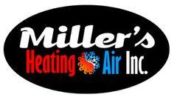Heating And Air 101
Most of people take heating and cooling for granted. They expect their heating systems to keep them warm during the winter, and they depend on air-conditioning to keep them cool during the summer. At Miller’s Heating and Air, we think it is important for our customers to know how heating and air systems work. Understanding how a HVAC system operates, can help make the decision of what type of system, is right for your home, a little easier.
How Heating and Cooling Systems Work
All climate-control devices or systems have three basic components: a source of warmed or cooled air, a means of distributing the air to the rooms being heated or cooled, and a thermostat control used to regulate the system. Heating and air systems come in two major forms. The most common central cooling system is a split system, which includes an outdoor cabinet containing a condenser coil and compressor, and an indoor evaporator coil, usually installed in conjunction with your furnace or air handler. The other option is a packaged system, which offers a more minimalist approach to heating and cooling. The system contains the same components as your typical split-system—the evaporator, condenser, compressor and more—all working together in one space-saving outdoor unit. The sources of warm air, such as a furnace or air handler, and cool air, such as an air conditioner, in a house use the same distribution and control systems. When a heating or cooling system malfunctions, any of these three basic components may be causing the problem.
Both heating and air conditioning work on the principle that heat always moves from a warm object to a cooler one, just as water flows from a higher to a lower level. Furnaces and heaters put heat into the air to make your home warmer; air conditioners remove heat to make your home cooler.
All heating and cooling units burn fuel. Air conditioners use electricity. Most home heating systems use gas or electricity. The heat pump, an electrically powered climate control unit — both heats and cools air. In summer it extracts heat from the air inside your home. In winter it pulls heat from the air outside and uses this heat to warm the air inside.
When the furnace or air handler is turned on, it consumes the fuel that powers it, whether it is gas or electricity. As fuel is burned, heat is produced and channeled to the living areas of your home through ducts, pipes, or wires and then is blown out of registers or heating panels in the wall, floor, or ceiling.
When an air conditioner is turned on, electrical power is used to cool a gas in a coil to its liquid state. Warm air in your home is cooled by contact with the cooling coil, and this cooled air is channeled to the rooms of your home through ducts and out of registers or — in the case of room air conditioners — directly from the unit itself.
